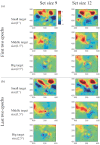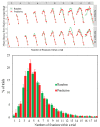How Attentional Guidance and Response Selection Boost Contextual Learning: Evidence from Eye Movement
- PMID: 32477438
- PMCID: PMC7246933
- DOI: 10.5709/acp-0274-2
How Attentional Guidance and Response Selection Boost Contextual Learning: Evidence from Eye Movement
Abstract
The contextual cueing effect (CCE) refers to the learned association between predictive configuration and target location, speeding up response times for targets. Previous studies have examined the underlying processes (initial perceptual process, attentional guidance, and response selection) of CCE but have not reached a general consensus on their contributions to CCE. In the present study, we used eye tracking to address this question by analyzing the oculomotor correlates of context-guided learning in visual search and eliminating indefinite response factors during response priming. The results show that both attentional guidance and response selection contribute to contextual learning.
Keywords: attentional guidance; contextual cueing effect; eye movement; response selection.
Copyright: © 2019 University of Economics and Human Sciences in Warsaw.
Figures








Similar articles
-
Revisiting contextual cueing effects: The role of perceptual processing.Atten Percept Psychophys. 2020 May;82(4):1695-1709. doi: 10.3758/s13414-019-01962-7. Atten Percept Psychophys. 2020. PMID: 31898062
-
Contextual cueing improves attentional guidance, even when guidance is supposedly optimal.J Exp Psychol Hum Percept Perform. 2017 May;43(5):926-940. doi: 10.1037/xhp0000394. Epub 2017 Feb 23. J Exp Psychol Hum Percept Perform. 2017. PMID: 28230395
-
Learning of association between a context and multiple possible target locations in a contextual cueing paradigm.Atten Percept Psychophys. 2020 Oct;82(7):3374-3386. doi: 10.3758/s13414-020-02090-3. Atten Percept Psychophys. 2020. PMID: 32710366
-
Mechanisms of contextual cueing: A tutorial review.Atten Percept Psychophys. 2019 Nov;81(8):2571-2589. doi: 10.3758/s13414-019-01832-2. Atten Percept Psychophys. 2019. PMID: 31410759 Review.
-
Implicit guidance of attention in contextual cueing: Neuropsychological and developmental evidence.Neurosci Biobehav Rev. 2019 Oct;105:115-125. doi: 10.1016/j.neubiorev.2019.07.002. Epub 2019 Aug 7. Neurosci Biobehav Rev. 2019. PMID: 31400351 Review.
Cited by
-
The abnormal implicit memory to positive and negative stimuli in patients with current and remitted major depressive disorder: A systematic review and meta-analysis.Front Psychiatry. 2023 Jan 10;13:1043987. doi: 10.3389/fpsyt.2022.1043987. eCollection 2022. Front Psychiatry. 2023. PMID: 36704726 Free PMC article.
References
-
- Beesley T., Vadillo M. A., Pearson D., Shanks D. R. Pre-exposure of repeated search configurations facilitates subsequent contextual cuing of visual search. Journal of Experimental Psychology: Learning, Memory, and Cognition. 2015;41:348–362. - PubMed
-
- Beesley T., Hanafi G., Vadillo, M. A., Shanks D. R., Livesey E. J. Overt attention in contextual cuing of visual search is driven by the attentional set, but not by the predictiveness of distractors. Journal of Experimental Psychology: Learning, Memory,and Cognition, 2018;44:707–721. - PubMed
-
- Caldara R., Miellet S. iMap: a novel method for statistical fixation mapping of eye movement data. Behavior Research Methods. 2011;43:864–878. - PubMed
-
- Chun M. M., Jiang Y. H. Contextual cueing: Implicit learning and memory of visual context guides spatial attention. Cognitive Psychology. 1998;36:28–71. - PubMed
-
- Chun M. M., Jiang Y. H. Top-down attentional guidance based on implicit learning of visual covariation. Psychological Science. 1999;10:360–365.
LinkOut - more resources
Full Text Sources
